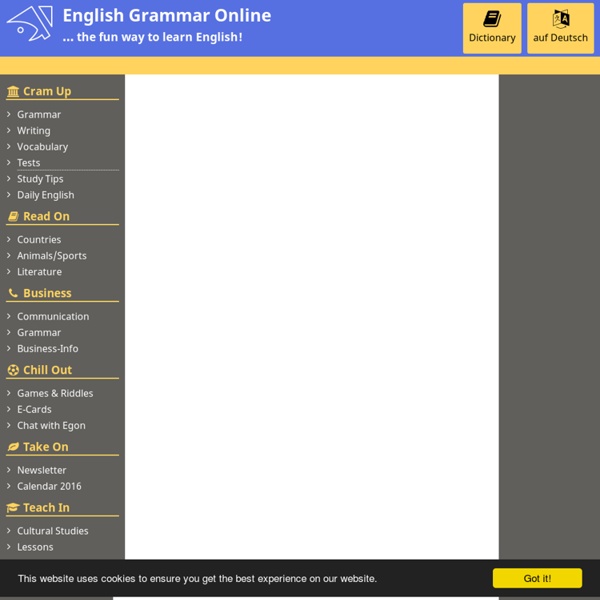



English Grammar Online - free exercises, explanations, vocabulary, dictionary and teaching materials Intermediate Quizzes - Intermediate Level English Learning Quizzes for ESL Grammar, vocabulary, listening comprehension, and reading comprehension quizzes for intermediate level students. These quizzes test basic English learning objectives. Intermediate English Grammar Review QuizThis quiz provides questions that cover each of the most important Grammar points that intermediate level English students need to know. Correct answers are provided after each question and a total score is given with feedback at the end of the test. Adjective Placement QuizTest your knowledge of using more than one adjective to describe a noun (i.e., an interesting old English book). Adverb Usage QuizIntermediate to advanced English learning quiz using a wide variety of adverbs to fill in the blanks to complete a short tale about someone who wanted to learn Russian. Animal Expressions QuizUpper level animal expression quiz focusing on animal expressions and words used with animals such as cub, scales, etc. Comparative FormsThis quiz focuses on comparative forms.
Genki English, ESL games, songs and ideas to turn ESL lessons into super lessons. Translate and Speak How to Use ImTranslator Translate and Speak • How to translate text and listen to the translation Do the following:• make sure that the Translate check mark box is ON• choose the target language for translation• adjust the speed of the voice• enter text or copy and paste text into the text window• press the Translate & Speak button ImTranslator will:• automatically detect the language of the text if the language detection was not correct, manually choose the language of the source text from the Translate drop-down box• translate text into the chosen language• convert the translated text into speech• read the text• highlight pronounced words• show the translation in the translation window• offer an option to create an audio link with a spoken text to embed it into an email, chat room, instant messenger or web site • How to play the voice without translation • How to create a link with a spoken text
Voy aprender inglés: letras de canciones en Inglés - lyrics En este apartado podrás encontrar letras de canciones en inglés. Ideales para favorecer el aprendizaje del idioma, adquirir vocabulario, practicar la pronunciación, etc. Love don't let me go - David Guetta feat The Egg, Letra y video de la canción Give me everything - Pitbull feat Ne-Yo & Afrojack, Letra y Vídeo de la Canción International Love - Pitbull feat Chris Brown, Letra y Vídeo de la Canción Mr. Get back (A.S.A.P) - Alexandra Stan, Letra y Vídeo de la Canción When love takes over - David Guetta feat Kelly Rowland Memories - David Guetta feat Cudi Sexy bitch - David Guetta feat Akon Club can't handle me - David Guetta feat Flo Rida Judas - Lady Gaga, Letra y Vídeo de la Canción Born This Way - Lady Gaga, Letra y Vídeo de la Canción The Edge of lory - Lady Gaga, Letra y Vídeo de la Canción Paparazzi - Lady Gaga, Letra y Vídeo de la Canción Just dance - Lady Gaga, Letra y Vídeo de la Canción Poker Face - Lady Gaga, Letra y Vídeo de la Canción Bad Romance - Lady Gaga, Letra y Vídeo de la Canción
Text To Speech, TTS: English, Spanish, French, Russian, Italian, German, Portuguese, Korean, Japanese, Chinese This natural sounding text to speech service reads out loud anything you like in a variety of languages and dialects in male and female voices. The TTS service speaks Chinese Mandarin (female), Chinese Cantonese (female), Chinese Taiwanese (female), Dutch (female), English British (female), English British (male), English American (female), English American (male), French (female), German (female), German (male), Hindi (female), Indonesian (female), Italian (female), Italian (male), Japanese (female), Korean (female), Polish (female), Portuguese Brazilian (female), Russian (female), Spanish European (female), Spanish European (male), Spanish American (female). Just type a word or a phrase, or copy-paste any text. Choose the speech rate that works for you. Start from any position on the text. Use this service to practice your listening and speaking skills, or master your pronunciation in foreign languages. Listen to any written materials in authentic voices while doing something else.
octubre 2009 English phrases and common sentences and expressions Muchas veces al conversar tenemos problemas en mostrar fluidez. A su vez, muchas veces nuestras conversaciones son frías y calculadas debido a que no usamos frases sino intentamos solo transmitir lo esencial por falta de práctica con frases en inglés. Es por esto, y por muchas mas razones, que aprender frases y oraciones comunes es esencial. Linguanaut contiene una interesante lista de frases y oraciones comunes en inglés. Lo que siempre les digo a mis alumnos es que un alto porcentaje de los alumnos que estudian inglés logran comprender y contestar pero muy pocos son los que llegan a dominar el “speaking”.
Tipos de Estudiantes de INGLES Curso de INGLES en LINEA gratis – Tipo de estudiantes de INGLES - ARTICULO #22 Bienvenidos, Hoy tenemos un nuevo artículo en donde mencionaré algunos tipos de estudiantes de inglés que existen. Enseñar ingles es un arte. Por ello a través del tiempo me he encontrado con diversos tipos de alumnos. Tipos de estudiantes de INGLES 1) El Analítico Siempre hay uno en cada clase. 2) El Comunicativo Le gustan los role plays, juegos, pair work y todo lo que involucre hablar. 3) El Práctico Estos alumnos sacan solo lo que les conviene de las clases. 4) El Memorista Les encantan las listas, los cuadros con explicaciones practicas y buscan patrones para memorizar. 5) El Traductor Los traductores siempre necesitan entender lo que se aprende en clase en su idioma nativo. 6) El Inquisitivo Mas conocido como el preguntón de la clase. 7) El Inseguro Mas conocido como el miedoso. Estos son algunas clases de los alumnos típicos en el aula.